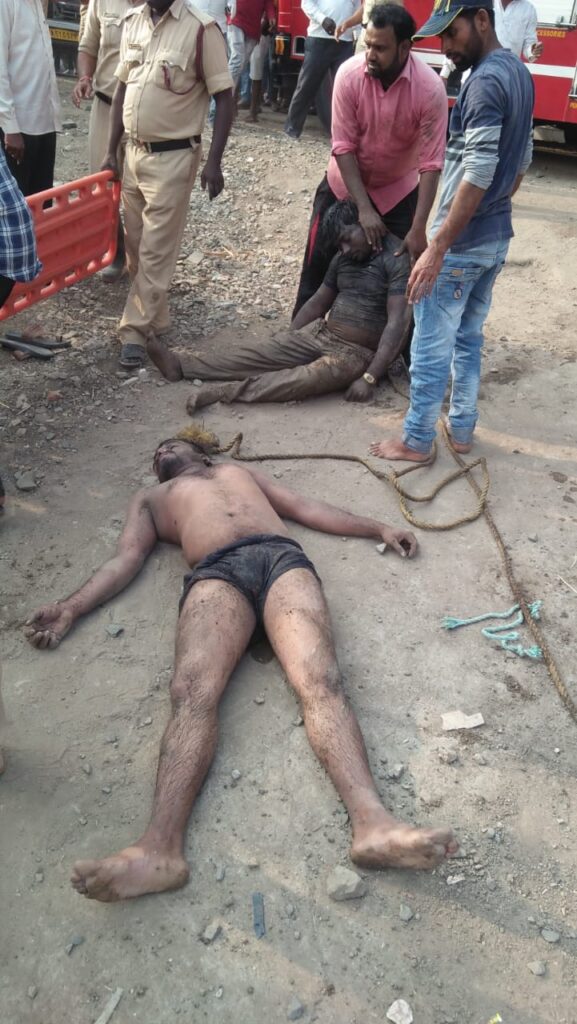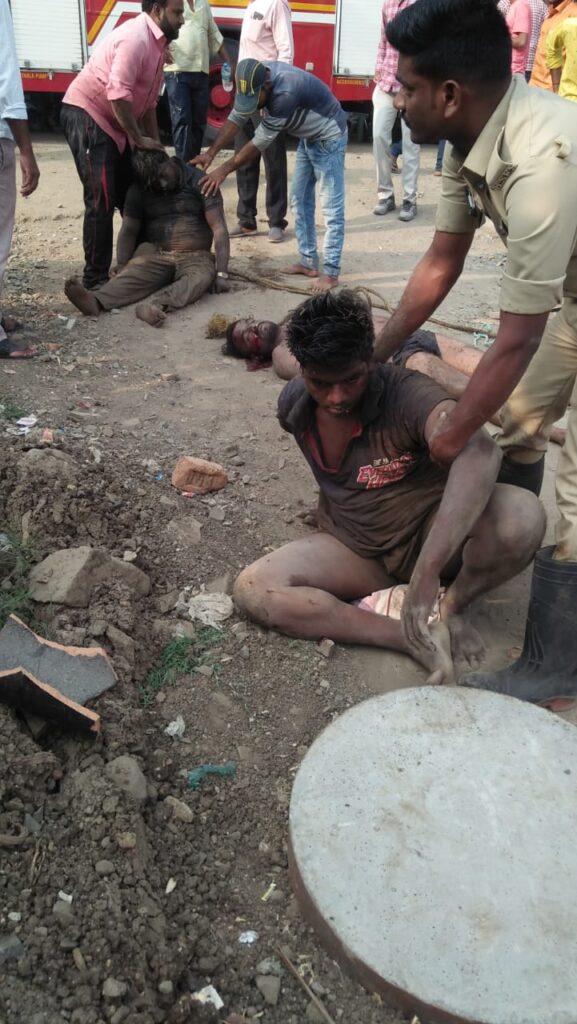Kalaburagi (erstwhile Gulbarga) is the second most densely populated city in Karnataka after Bengaluru, with a density of 8824 persons per sqm. It is also a rapidly expanding city. Huge investments have been made in building the underground drainage network in the city. Just under the Atal Mission For Rejuvenation And Urban Transformation (AMRUT) scheme, 230 kms of sewer lines with over 8000 manholes is nearing completion by Karnataka Urban Water Supply & Drainage Board (KUWS&DB). Apart from AMRUT schemes, sewer lines have been constructed under North Karnataka Urban Sector Infrastructure Programme (NKUSIP) by Karnataka Urban Infrastructure Development and Finance Corporation (KUIDFC). As per the Kalaburagi Mahanagara Palike estimates, the city now has a 700km-long underground drainage network. But as has become a pattern with sanitation programmes in India (Swachh Bharat Mission or Smart City Mission are prime examples), a lot of investments are made into the infrastructure itself, but not enough attention is paid to the operation and maintenance of this infrastructure. In other words, those who design and implement these projects hardly ever bother about those who would end up cleaning these toilets, manholes and sewer lines. For Kalaburagi city, the KUWS&DB which is in-charge of maintenance of the underground drainage system, has exactly 3 Sucking and Jetting Machines and 1 Desilting machine!
As a result not only is informal manual scavenging work rampant, even those sanitation workers who are hired by the KUWS&DB itself, either directly or through contractors, routinely get inside manholes and clear blockages. According to activists who work with the safaikarmachari community in the city, there are 800-1000 workers who engage in various forms of manual scavenging in Kalaburagi city, spread over Tarphel, Indiranagar, Ghazipura, Santraswadi, Mahboob Nagar, Azadpur Road, Tipu Chowk, Panchasheelanagar and Umar colony localities. The workers belong to Valmiki (Dalit) and Muslim community in equal numbers. This singular fact explains why crores have been spent on building sewer lines but small investments in functioning mechanical equipment like Sucking and Jetting Machines and Desilting machines which could prevent loss of precious lives, is oft en an afterthough.
Out of the estimated 800-1000 persons engaged in manual scavenging in the city, only 243 persons were identified as manual scavengers by the Kalaburagi Mahanagara Palike in 2018 through ‘surveys’ which were essentially one-day camps where self-declaration forms were invited from those engaged in manual scavenging. The process was in complete violation of the survey protocol prescribed by the Prohibition of Engagement as Manual Scavengers and their Rehabilitation Act 2013 and the Rules thereunder. Unsurprisingly, the half-hearted attempt by the Mahanagara Palike left out several hundreds of workers, who continue to make a living through this hazardous work in absence of any rehabilitation from the government.
Among them are the 25-30 workers residing in Umer colony, whose families have been engaged in manual scavenging for several generations. 55-year old Burhan Sheikh, a resident of Umer colony, started working for KUWS&DB in 1982 at a salary of INR 270 per month as a sanitation worker. He used to clear sewer blockages with a bamboo stick. Before him, his father used to be engaged in the same work. Burhan has not been registered as a manual scavenger since, as per the logic of Mahanagara Palike, he now has a permanent job as a UGD worker in KUWS&DB. Several members of Burhan Sheikh’s family including his sons and his grand-son also joined him in this work as sanitation workers under KUWS&DB but on a contract basis.

Burhan Sheikh had lost his older son, Mahboob Sheikh, about 5 years ago. Mahboob Sheikh was opening a sewer chamber when he complained of discomfort in his chest. Instead of taking him to hospital, the KUWS&DB contractors sent him back to his house. After cycling back to his house in Umer Colony, Mahboob Sheikh collapsed and died. KUWS&DB neither paid any compensation to his family, nor offered any job to any of his family members on compassionate grounds.
On the morning of 28th January 2021, Burhan Sheikh’s son Lal Ahmad (36) got a call from the contractor, who asked them to come to the junction road between Kailash Nagar and Mahalaxmi Layout. The sewer line flowing along the road had been blocked for several months and the KUWS&DB had been receiving constant complaints from the residents. Lal Ahmad, Rashid Sheikh (Burhan’s grandson) and Raj Ahmad (Burhan Sheikh’s youngest son), Tasneem Sheikh and two other residents of Umer Colony, who usually work together, reached the spot where the UGD was blocked. As per eye-witness accounts, the Sucking and Jetting Machine which was called, was unable to clear the blockage because of the presence of silt and stone pieces blocking the sewer line. When the lone Desilting Machine was called, it was unavailable. The contractor then asked the workers to get down inside the man-hole and clear the blockage with a bamboo-stick. When the workers refused to take the risk, the contractor promised to clear their pending 3-4 months’ wages, if they did this one task. All this while, the contractor and the private company supervisor were in touch with KUWS&DB officials.
Desperate for getting their pending wages, Rashid Sheikh first entered the 18ft manhole and tried to clear the blockage with a bamboo stick. As soon as the silt and stones were cleared, the septage and noxious gases spurted out from the sewer line onto Rashid Sheikh’s face. He started to lose consciousness and tried to climb back up but was unable to do so. Lal Ahmad went down to bring back Rashid but the concentration of noxious gases was so high that he too became unconscious and fell inside the manhole. Raja Ahmad, also fell in attempting to pull out his colleagues. The other three workers and the contractor who were outside the manhole brought a rope and were able to pull out Raja Ahmad since he was closer to ground level. But Lal Ahmad and Rashid Sheikh had fallen deep inside the manhole, and they could only be pulled out after a JCB was called in to break open the manhole. Both Lal Ahmad and Rashid Sheikh were dead on the spot while Raja Ahmad was rushed to the District Hospital in a serious condition.
The subsequent events followed the usual script – the police didn’t register an FIR till few organizations staged a rasta roko protest. When the FIR was filed, weaker provisions of IPC (Sec 304A – Negligence) were invoked instead of more appropriate sections (IPC 304 Part II – Culpable Homicide) and while the list of accused included KUWS&DB officials, their names were mis-spelt in the FIRs. The KUWS&DB first tried to negotiate the compensation amount with the family and settled on Rs 5 lakh which is in complete violation of the Supreme Court directions in Safai Karamchari Andolan vs Union of India.
The statements of officials from Kalaburagi Mahanagara Palike and the KUWS&DB tried to paint this as an accident. According to them, the workers slipped and fell into the manhole. The workers can be seen in their undergarments in the pictures from the spot. Why would they remove their clothes if the manhole was being cleaned through a machine? How would three people slip all at once and fall into the manhole? The Chief Engineer, Kalaburagi Division, KUWS&DB even claimed that the workers “would have been drunk, don’t you know these people?” and suggested “de-addiction counseling” as a preventive measure! Conversation at Umer Colony with others who work as manual scavengers revealed that it was not uncommon for contractors to ask workers to get inside the manholes. The workers indicated several places like Basaveshwara Hospital etc where they have gone inside manholes. But the government keeps claiming that there is no manual scavenging in Karnataka!
Report in Kannada published in February 2021 edition of Slum Jagatthu Monthly Magazine.
Gulburga-MS-death-Incident-report-KannadaFact-finding Report by Safaikarmachari Kavalu Samithi-Karnataka
gulburga-FFT

